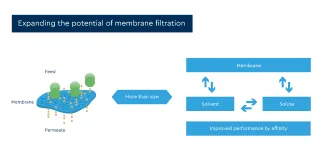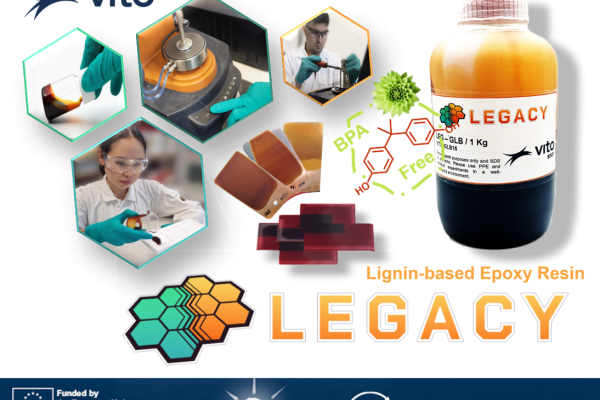Innovative membrane technology to filter endocrine disruptors from wastewater
So-called endocrine-disrupting chemicals (EDCs) are chemicals that, above certain exposure thresholds, can disrupt endocrine systems. This entails health risks. In Flemish waterways and rivers, the concentrations of EDCs are too high to simply exclude an effect. Together with Inopsys, a developer of innovative methods and mobile, on-site water purification installations, VITO is already looking at how the substances can be filtered out of wastewater using innovative membrane techniques. So that a solution will be available when environmental legislation is strengthened.

Chemicals that can interfere with human hormone systems
Through our living environment, we are continuously exposed to a wide range of chemicals. As long as this exposure remains below certain threshold values, there is no problem for our health. That is why many chemicals are subject to strict regulation. But this does not apply to all chemicals that can potentially cause health problems. Endocrine disruptors, or EDCs, have long been considered with suspicion by scientists. These chemicals, which are present in many products (for example, in detergents, such as bisphenol A), can interfere with human hormone systems.
This can increase the risk of hormone-related diseases and disorders. Diabetes, reduced fertility and certain cancers (including prostate cancer) are just a few examples. However, the actual and concrete health risk for many EDCs is still not well known. This explains why many of these substances are currently under-regulated and are, as such, still allowed to be used in industrial production processes. And why they are found in watercourses, rivers and also in groundwater in concentrations that are not negligible - they end up in surface water through domestic and industrial wastewater.
EDCs OR ENDOCRINE DISRUPTORS ESCAPE CONVENTIONAL WATER TREATMENT
In Flemish rivers and waterways, EDC concentrations flirt with the threshold values that scientists have proposed as acceptable maximum concentrations (in scientific jargon: predicted no-effect concentrations). Of course, the situation differs from region to region and from river to river. For example, concentrations will be higher in densely populated areas and highly industrialised regions than elsewhere.
The problem is that EDCs escape conventional water purification. And VITO wants to do something about this, in cooperation with the Mechelen-based company Inopsys. Inopsys researches, designs and develops mobile and modular on-site water purification systems, for the chemical and pharmaceutical industries. Within the last project SuMEMS, which was supported by Catalisti (the Flemish spearhead cluster for the chemical and plastics industry), Inopsys already investigated how its technology can help with the on-site purification of complex organic, solvent-rich waste water flows. ‘The processing of such waste flows in the pharmaceutical and fine chemicals industry is currently still very unsustainable,’ says Dirk Leysen of Inopsys. As part of this project, Inopsys installed a pilot system based on membrane technology at a pharmaceutical company to purify and process the waste water on the spot so no more trucks need to drive back and forth.
In the future, Inopsys hopes to work with VITO on a similar demonstration of an industrial, on-site purification plant specifically for EDCs. The groundwork for this has already been laid in the Ecoremedi project, which began in June 2020 and is due to end soon - Ecoremedi stands for EcoFriendly Removal of Endocrine Disruptors. ‘In this project, we investigated how we, with the innovative membrane technology and expertise of VITO and Inopsys, could develop solutions to remove EDCs from wastewater,’ says Sara Salvador Cob of VITO. The project not only focused on EDCs, but also on so-called pro-EDCs. ‘These are substances that are not harmful to health in themselves, but which can break down into EDCs.’
Within Ecoremedi, the work was mainly at laboratory level. ‘It was all about knowledge creation and research data collection, where, for example, we did tests on different complex aqueous mixtures and solutions,’ Salvador Cob continues. An innovative way to remove EDCs is to bring them into contact with certain natural molecules, selected by Inopsys. The advantage is that these molecules can indeed be contained by membranes. ‘Via pressure-driven membrane filtration, such as nanofiltration and reverse osmosis, we can purify a waste stream by separating these larger molecules containing the EDCs.’ The researchers from VITO and Inopsys have already found two membrane types that are very suitable for this purpose.

Effective purification technology for EDCs
The membrane technology appears to work and to have a sufficiently large purification capacity. Follow-up research must examine how fast the process runs, how much membrane surface is required and how the membranes must be maintained. This research could then lead to a pilotscale demonstration. And this will probably also involve the VITO spin-off that was founded at the end of 2021. After all, A-membranes produces ceramic membranes that could be suitable for membrane extraction of EDCs.
Meanwhile, membrane extraction as a technology in itself is also further investigated within EASiCHEM, an SBO project that is again being supported by Catalisti and in which, among others, separation processes via membranes are studied and optimised. This project, in which both VITO and Inopsys are involved, runs until 2023.
In their search for a purification technology for EDCs, VITO and Inopsys are doing very proactive research. Leysen: ‘There’s a good chance that the environmental legislation on EDCs will soon be strengthened, and so it’s best to have an effective solution.’
VITO and Inopsys have been working together for many years, sharing a long and rich experience in the field of membrane technology. ‘Our expertise and activities are very complementary,’ says Leysen. ‘Membranes are a fantastic technology, but there is a lot involved in optimally integrating them into a separation process. For example, a pre-treatment is needed and after separation, all kinds of ‘leftovers’ need to be cleared. We are specialisists in these matters.’
Whereas until recently, cooperation between VITO and Inopsys was rather project based, it is now confirmed in a long-term cooperation agreement. ‘This consolidates our good cooperation so far and guarantees it in the long term,’ says Roel Vleeschouwers of VITO. The agreement includes concrete agreements on the allocation of intellectual property. ‘VITO and Inopsys have known each other for a long time,’ says Leysen. ‘There is mutual trust and VITO will continue to be our preferred partner in the future.’












